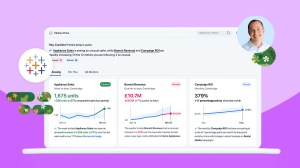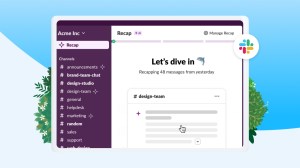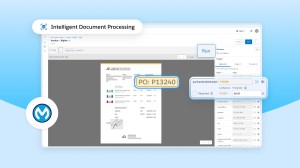In our increasingly data-driven world, businesses need to understand their data, gather insights, and make decisions fast.
Historically, seeing and understanding data was limited to data experts. The future, though, is making insights accessible to everyone in their flow of work, powered by unified, real-time data, and with generative AI explaining both what the data means — and how someone could act on it.
Salesforce took a big leap into that future by announcing Tableau GPT, which uses generative AI to better understand and interact with data, and Tableau Pulse, which taps AI and unified, real-time data to proactively surface personalized insights with natural language and a visual format.
Here, Tableau Chief Product Officer Francois Ajenstat shares how — by bringing the power of generative AI to analytics and combining it with Data Cloud — Tableau is empowering everyone to make smarter, data-driven decisions.
Q. Why does Tableau care so much about making data more accessible?
Organizations must be data driven to survive and thrive. The reality is, data-driven companies are more successful — they retain customers, have mastered profitable growth, and will be a better company to work for. However, most people in organizations don’t have the training or time to digest and interpret their data to make decisions — they leave it up to a small cadre of experts who are stretched thin.
Tableau’s mission is to empower anyone to see and understand their data for better decision-making. If we can help every person — whether they’re a data analyst or a regular business user — infuse data and analytics in their flow of work and make it easy to act on, we’ll be able to drive better decisions and outcomes for that organization.
Q. What’s significant about the newly-announced Tableau GPT innovation, and how does it work?
At Tableau, we’ve always focused on making the complex simple.
Tableau GPT brings generative AI to data and analytics so that you don’t have to be a data expert to understand data. Users can generate insights in a conversational way by asking questions within Tableau. Tableau Pulse uses Tableau GPT to automate analytics, surfacing insights in both natural language and visual format, so users receive proactive insights in a digestible and shareable form.
Tableau GPT technology is layered on top of VizQL, our proprietary visual query language, which helps translate human intent into database queries. Tableau GPT learns what kinds of questions people are asking it, and sends that to VizQL in the background, enabling GPT recommendations to get smarter and more accurate. Results from queries can be visualizations or fully formed narratives thanks to Data Stories, which transforms data into natural language stories.
With Tableau GPT, data will feel more like a colleague that has your back, tapping your shoulder when there’s something you should engage with. The more you collaborate with that colleague, the more they collaborate back, and together, you’re able to find solutions to problems faster and more reliably than if you were working alone.
With Tableau GPT, data will feel more like a colleague that has your back, tapping your shoulder when there’s something you should engage with. The more you collaborate with that colleague, the more they collaborate back, and together, you’re able to find solutions to problems faster and more reliably than if you were working alone.
Q. Can you provide an example of how Tableau Pulse will help companies get more out of their data?
Imagine a store manager who wants to spend less time manually analyzing complex monthly sales for reasons why they’re down, or trying to understand inventory holdup implications, and more time connecting with customers to drive revenues. With Tableau Pulse, this manager can get a complete picture of their business — either directly in Slack or in their inbox. They can focus their attention on the metrics that have anomalies or outliers. And they can ask questions of their data in natural language, like ‘how much inventory do I have’ or ‘which products have had the most returns’ and get simple answers quickly to inform product displays.
Or, imagine a manufacturer tracking their supply chain. Tableau Pulse can proactively send notifications if certain products are not delivered on time, or if there’s outliers or disruptions in the data they need to act on.
The other very powerful use case is using Tableau GPT as an assistant to help perform an analysis. Where before only a small subset of data analysts had the expertise to write calculations or build transformations, the amount of people who can see and access this data is now 10x thanks to Tableau GPT. Everyone will be more data-informed as a result.
Q. We’ve been saying AI is only as good as the data that powers it. What makes Salesforce and Tableau’s AI + data offering unique?
To get the most out of generative AI, people need to trust that the questions they ask give trusted answers back. With Tableau GPT, the output is always grounded in analysis directly on a company’s proprietary and trusted data — not just information from the internet. This data is also coming from across Salesforce Customer 360, in real time, thanks to Data Cloud.
Normally, it’d be a long process from when data is generated to when users can work with it, access it, and then act on it. By integrating data and analytics at the heart of the Customer 360, users can create AI-powered insights in real time to power better solutions for customers.
Q. Now, with Data Cloud in Tableau, what can companies do differently with their data and insights?
Companies are drowning in data and lacking in insights. There’s so much data coming in faster than ever, and getting a complete picture has historically been a challenge. A recent Salesforce study found that organizations today use over 1,000 applications, but 70% remain disconnected from one another and the core business, leading to data silos.
With Data Cloud, we’re able to provide data connectivity, data integration, and harmonization that turns every customer touchpoint into unified, real-time profiles of a customer. All of that data is natively accessible by Tableau, providing fast, analytically-ready content that users can share out easily, like visualizations.
I like to say that data analysis without action is a missed opportunity and with Data Cloud we bring data, with Tableau we bring analysis, and combined we help users drive action at scale.
Q. Salesforce has revolutionized CRM, brought real-time data to customers with Data Cloud, and introduced the world’s first generative AI for the enterprise. What does AI + data + CRM mean for businesses?
Today, as customers accelerate their digital transformations, they’re generating more data than ever before — a data transformation, if you will. Tableau is helping to unlock the value of this data in the Customer 360 so businesses can connect with their customers in a whole new way. AI, including generative AI, layers into the Customer 360 a system of intelligence that makes everything simpler and more powerful, enabling teams to spend more time on the things that matter, rather than the boring tedious tasks of the past.
Here’s how I think about it. Salesforce unites companies around customers. Tableau unites people around data. Together, we unite companies around their customer data, and now, with generative AI in Einstein, Tableau, and more, we do this even more intelligently than before.
Q. Forty-one percent of business leaders cite a lack of understanding of data because it is too complex or not accessible enough. One-third (33%) of business leaders cite the lack of ability to generate insights from data. When you speak with customers, what are their experiences with data and their biggest concerns?
When I talk to customers, the majority can’t access their data. It’s not approachable in the way they’d hoped.
On the flipside, customers making the most of their data have learned this simple lesson: When you empower your people with data, everyone wins. I recently met with a customer who is trying to help their financial advisors provide better client service. They wanted their advisors to have a complete picture of their customers, with actionable, trusted analytics data visible in their existing systems, to serve them better. They’re using Tableau now, and the advisors are much more informed and engaged, and able to focus on what matters: cultivating relationships with their customers.
Trust is critical. Companies need to trust their data, and that is so fundamental to what we do at Salesforce. They also need easy solutions that enable curiosity and exploration — not technology that creates more walls, but rather breaks down existing walls and helps people explore and share learnings as they go about their day. The future is all about democratized analytics in the flow of work, and providing everyone with an AI assistant that helps them see and understand their data in new ways.
Learn more about Tableau innovations here.
















